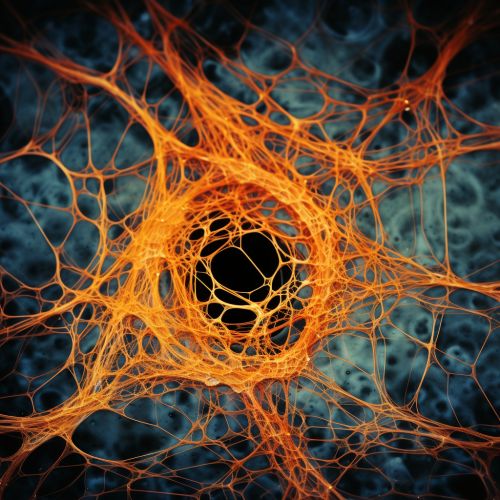Intermediate Filament
Overview
Intermediate filaments (IFs) are a type of cytoskeletal component found in the cells of vertebrates, and some invertebrates. They are named for their intermediate diameter, falling between the larger microtubules and the smaller microfilaments. IFs play a crucial role in maintaining cellular and tissue integrity, and are involved in a variety of cellular processes, including cell shape maintenance, intracellular transport, and cellular signaling read more.


Structure
Intermediate filaments are defined by their structure rather than their composition, which can vary widely. They are composed of fibrous proteins that form a coiled-coil structure, a configuration where two alpha-helical proteins wrap around each other to form a supercoil. This structure is then assembled into a staggered tetramer, which forms the basic subunit of the intermediate filament. These tetramers align in a parallel fashion and pack together laterally to form a compact, cable-like filament.
Types
There are six types of intermediate filaments, classified based on the amino acid sequence and molecular weight of their protein subunits. These include keratins, vimentins, neurofilaments, lamins, nestins, and the orphan group. Each type of intermediate filament is expressed in a specific cell type or during a specific stage of cellular development.
Keratins
Keratins are the most diverse group of intermediate filaments and are found in epithelial cells read more. They play a crucial role in maintaining the structural integrity of these cells and are involved in the formation of hair, nails, and the outer layer of skin.
Vimentins
Vimentins are expressed in mesenchymal cells, which are a type of connective tissue cell. They play a role in maintaining cell shape and integrity, and are involved in cell adhesion and migration.
Neurofilaments
Neurofilaments are found in neurons and are essential for the radial growth of axons. They are composed of three subunits: neurofilament light (NFL), neurofilament medium (NFM), and neurofilament heavy (NFH).
Lamins
Lamins form a network of intermediate filaments at the inner nuclear membrane, providing structural support to the nucleus. They are also involved in DNA replication and transcription, as well as nuclear and cell division.
Nestins
Nestins are expressed in neural stem cells and are involved in the process of neurogenesis, the formation of new neurons from these stem cells.
Orphan group
The orphan group of intermediate filaments includes several proteins that do not fit into the other categories. These include synemin, paranemin, and desmuslin.
Functions
Intermediate filaments play a crucial role in maintaining cellular and tissue structure. They provide mechanical strength to cells, helping to resist physical stress. They also contribute to the organization of the cell, positioning organelles and other cytoskeletal elements.
In addition to their structural roles, intermediate filaments are involved in a variety of cellular processes. They participate in cell signaling, acting as a scaffold for signaling molecules. They also play a role in cell movement and migration, contributing to the formation of the leading edge of migrating cells.
Diseases associated with Intermediate Filaments
Mutations in the genes encoding intermediate filament proteins can lead to a variety of diseases, collectively known as intermediate filamentopathies. These include skin disorders, neurological diseases, and muscular dystrophies.
